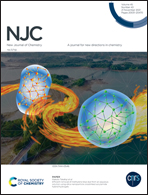9-Arylacenaphtho[1,2-b]quinoxalines via Suzuki coupling reaction as cancer therapeutic and cellular imaging agents†
Abstract
Current research based on the development of promising anticancer chemotherapeutics is a great challenge to scientists to combat the pervasiveness of pernicious cancer. In line with this, the aim of this work is to develop a set of 9-arylacenaphtho[1,2-b]quinoxaline analogues with the capability of imaging, as well as terminating, cancer cells in the human body, exploiting the powerful anticancer activity of the quinoxaline and acenaphthene moieties. The rigid, planar disc like framework of acenapthoquinoxalines gives them the ability to intercalate to helical DNA via π–π stacking, and the fluorescence properties of these compounds has been increased with the extension of π-conjugation by introducing various aryl groups to the core moiety via a Suzuki coupling reaction. Precise cytotoxicity screening has revealed that compound 5a is the most potent and selective (with respect to HEK 293 cells) compound among all members of this series, showing IC50 values of 1.97 ± 1.29 μM, 3.06 ± 1.07 μM and 22.01 ± 0.77 μM against the human cervical cancer (HeLa), human breast cancer (MCF-7) and human brain cancer (U87MG) cell lines, respectively. Compound 5c has been recognised as the fluorescent imaging agent with the highest quantum yield (φ = 0.1458). Furthermore, the considerable cellular uptake, nucleus targeting aptitude and DNA damaging qualities of these compounds, and above all the annihilation of cancer cells, have been certified by flow cytometry, colocalisation studies, binding studies and DNA gel ladder assays, along with morphological analysis and scratch wound healing assays.
![Graphical abstract: 9-Arylacenaphtho[1,2-b]quinoxalines via Suzuki coupling reaction as cancer therapeutic and cellular imaging agents](/en/Image/Get?imageInfo.ImageType=GA&imageInfo.ImageIdentifier.ManuscriptID=D1NJ03915F&imageInfo.ImageIdentifier.Year=2021)


 Please wait while we load your content...
Please wait while we load your content...